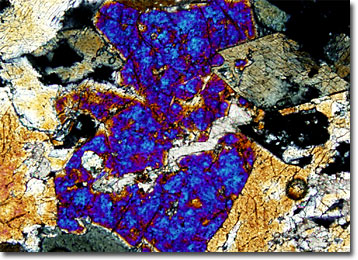Polarized Light Microscopy Digital Image Gallery
Diopside Gneiss
Gneiss is a medium- to coarse-grained rock that characteristically exhibits a banded appearance due to the physical segregation of the minerals of which it is comprised. Yet, despite its layered appearance, gneiss does not readily cleave along the planes of its bands.

View a second image of Diopside Gneiss
Though it often contains significant amounts of feldspar and quartz, gneiss is an extremely various type of rock. Thus, in order to more adequately describe a specific gneiss, the rock is frequently classified according to a number of more restrictive systems. Many of the common categorizations of the rock are based upon chemical composition, parent material, or mineral constituents. Gneiss diopside is an example of this latter type of categorization.
Diopside, the characteristic component of diopside gneiss, is an important rock-forming silicate mineral found in many metamorphic and igneous rocks, as well as meteorites. A member of the pyroxene family, diopside is part of a chemical replacement series that also includes hedenbergite and augite. Iron and magnesium ions can be freely substituted between these three minerals. Although it is frequently a lustrous white or green in color, diopside may exhibit a variety of hues and patterns. A blue form, for instance, is found occasionally in Italy and is called violan, while a dark type of diopside with rutile needles aligned in a stellar-like formation is commonly known as star diopside.
